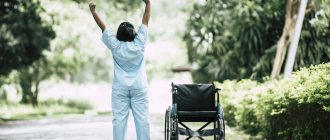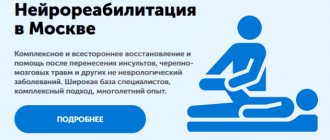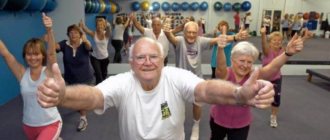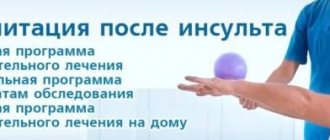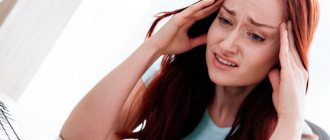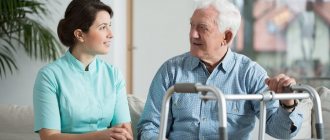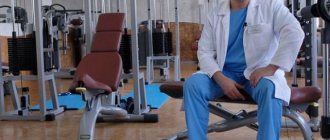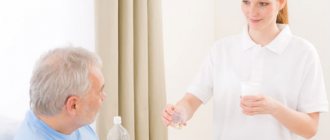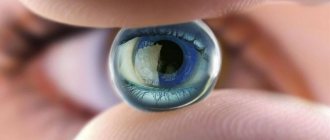People who have suffered a stroke have the possibility of full or partial recovery. Experts insist on carrying out rehabilitation measures for three years.
As a rule, ischemic stroke gives more hope, since it is characterized by less dangerous damage to the cells of the cerebral cortex and the use of “spare” vessels for nutrition. In the hemorrhagic form, physical rehabilitation is limited to preventing recurrent circulatory disorders, timing of hematoma resorption, and the use of surgical intervention.
Gymnastics after a stroke is part of planned rehabilitation measures along with medications, physiotherapy, diet, and regimen.
What problems does exercise therapy solve after a stroke?
Exercise therapy for stroke plays an important role in the prevention of complications, the development of a person’s adaptation to self-care, and the acquisition of lost functions.
A long period of forced immobility in bed is dangerous for the development of severe consequences. The exercise therapy complex helps prevent:
- formation of bedsores on the buttocks, back;
- congestive pneumonia;
- the occurrence of heart failure;
- progressive atrophy of non-working muscles;
- formation of blood clots followed by embolism in vital organs;
- spasm of muscle groups with increased tone during paresis and spastic paralysis, formation of contractures (change in limb shape).
Gymnastics after a stroke has a positive effect on microcirculation and metabolism in organs and tissues that are reduced as a result of the disease. It allows you to resume active movements and, in the long term, helps you gain the ability to draw, write, and use dishes and household appliances. Leads to normalization of the functioning of internal organs (urination, defecation), helps restore speech.
Speech rehabilitation
Speech disorders after a stroke are observed in more than a third of patients who have suffered acute cerebrovascular accident. It is necessary to understand that the concept of “speech impairment” implies not only a violation of one’s own voluntary speech (motor aphasia), but also a violation of the understanding of the speech of others (sensory aphasia), forgetting of individual objects and actions (amnestic aphasia), and there are also combined manifestations of these conditions. Another common type of speech impairment after a stroke is dysarthria - a violation of the correct articulation of sounds while maintaining “inner speech”, understanding the speech of others, reading and writing.
The main factor for success in restoring speech functions is systematic long-term classes on the development of speech, reading and writing, which are conducted by a speech therapist-aphasiologist or under his direct supervision.
It is necessary to begin speech restoration classes in the acute period of a stroke, as soon as the level of consciousness allows. At this stage, classes are short - no more than 15-20 minutes. Subsequently, the duration increases to 30-45 minutes or more. In such a situation, speech isolation of the patient is very dangerous. Relatives and friends of the patient must understand that not only special classes, but also ordinary constant everyday speech contact with the patient and reading books in themselves contribute to the restoration of both his own speech and understanding of the speech of others. Consequently, the timing of the patient’s return to normal life after a stroke depends on the atmosphere created by the loved ones around him.
When can you start exercising?
Beginning to use physical activity, its volume. The target orientation is determined by the attending physician. It depends on the:
- the extent of damage to brain tissue;
- sufficient ability of the body to recover;
- timeliness and completeness of treatment.
The first 6 months are considered the acute period. At this time, changes occur in the ischemic focus: some cells die irrevocably, while others retain the ability to perform their functions, but need help. This is exactly what exercises after a stroke are designed to do. At the cellular level, there is a special memory that should “remember” the range of movements and restore the transmission pathways of nerve impulses.
If the patient is not in a coma and consciousness is preserved, then on the third day he is recommended to begin breathing exercises. Its goal is to prevent congestion in the lungs. From the fifth day, physical therapy (PT) is prescribed. The sets of exercises include familiar movements, taking into account the patient’s condition, the ability to sit or stand independently, and the degree of loss of motor functions.
It is recommended to continue physical education after discharge at home. To do this, loved ones should learn the necessary exercises themselves, support and encourage the patient’s aspirations. Positive emotions and good mood play a significant role in the speed of rehabilitation.
In the later period (after six months or more), the patient needs to use a rehabilitation course of treatment in specialized centers and sanatoriums. It is recommended to repeat therapy 2 times a year. Here, in addition to the physical education rehabilitation complex, there are opportunities for extended physiotherapeutic treatment under the supervision of medical personnel:
- oxygen baths;
- massage;
- acupuncture;
- hardware electrical stimulation of paralyzed muscle groups;
- pulsed magnetic therapy;
- electrosleep.
Neurostimulation of the leg muscles is performed
How to help yourself
Contrary to popular belief, it is strictly forbidden to independently engage in exercise therapy after a stroke at home, even if the illness experienced is characterized by the absence of negative symptoms. At the first stage, the patient in any case requires outside help - from medical workers or relatives.
At this time, close people should make sure that the patient does not dwell on negative thoughts and focuses on the correct implementation of exercise therapy after a stroke. In addition to physical therapy, one must remember to take prescribed medications, physiotherapy and massage in a timely manner.
For help, you can always contact our boarding house for the elderly and we will help you
How to do breathing exercises?
While lying down, the patient simply needs to take a few deep breaths, repeat throughout the day as often as possible. When the doctor allows you to sit, it is important not to bend your back, but to keep it straight so that the air can straighten your lungs as much as possible.
Breathing exercises involve taking a slow, deep breath, holding your breath for a few seconds, and then gradually exhaling. After each such breath, the patient needs rest. You need to make sure that dizziness does not increase, and do not strain while holding your breath.
There are options for controlling long exhalation:
- inflating a rubber ball;
- using a cocktail straw dipped into a cup of water.
The patient feels the result of his work by the volume of the ball and the gurgling of the liquid. In the future, you can begin to master a course of exercises using Strelnikova’s method.
What exercises can you do lying down?
If the patient is not allowed to sit and stand up or cannot do this, the exercises are carried out first in a passive mode, then in an active mode.
Passive physical education means the absence of participation of the patient, the use of the efforts of another person
Exercises are limited to movements in the joints of the arms and legs. The complex gradually includes passive flexion, extension, rotation, abduction and adduction with increasing amplitude. You should not immediately try to fully complete the maximum option. Start with small vibrations up to 15 movements in each joint 3-4 times a day.
It is recommended not to forget about the sequence of joint development: from the center to the periphery. In other words, exercises for the arm begin with the shoulder, then move on to the elbow joint, wrist and hand. Similarly on the legs: from the femur to the small joints of the foot.
Passive exercises in the hand with monoparesis can be performed by the patient himself with the help of a healthy hand. As a device for self-study, a loop made of fabric or wide rubber is used, into which the patient threads a stationary limb and performs movements, clinging to it.
The patient performs active exercises independently. Special complexes have been developed for this purpose. They begin lying down and continue in a sitting position.
Experts insist on carrying out rehabilitation measures for three years after a stroke. As a rule, ischemic stroke gives more hope, since it is characterized by less dangerous damage to the cells of the cerebral cortex and the use of “spare” vessels for nutrition. In the hemorrhagic form, physical rehabilitation is limited to preventing recurrent circulatory disorders, timing of hematoma resorption, and the use of surgical intervention. Gymnastics after a stroke is part of planned rehabilitation measures along with medications, physiotherapy, diet, and regimen.
What problems does exercise therapy solve after a stroke?
Exercise therapy for stroke plays an important role in the prevention of complications, the development of a person’s adaptation to self-care, and the acquisition of lost functions. A long period of forced immobility in bed is dangerous for the development of severe consequences. The exercise therapy complex helps prevent:
- formation of bedsores on the buttocks, back;
- congestive pneumonia;
- the occurrence of heart failure;
- progressive atrophy of non-working muscles;
- formation of blood clots followed by embolism in vital organs;
- spasm of muscle groups with increased tone during paresis and spastic paralysis, formation of contractures (change in limb shape).
Gymnastics after a stroke has a positive effect on microcirculation and metabolism in organs and tissues that are reduced as a result of the disease. It allows you to resume active movements and, in the long term, helps you gain the ability to draw, write, and use dishes and household appliances. Leads to normalization of the functioning of internal organs (urination, defecation), helps restore speech.
When can you start exercising?
The beginning of the use of physical activity, its volume, and target orientation are determined by the attending physician depending on:
- the extent of damage to brain tissue;
- sufficient ability of the body to recover;
- timeliness and completeness of treatment.
The first 6 months are considered the acute period. At this time, changes occur in the ischemic focus: some cells die irrevocably, while others retain the ability to perform their functions, but need help. This is exactly what exercises after a stroke are designed to do. At the cellular level, there is a special memory that should “remember” the range of movements and restore the transmission pathways of nerve impulses. If the patient is not in a coma and consciousness is preserved, then on the third day he is recommended to begin breathing exercises. Its goal is to prevent congestion in the lungs. From the fifth day, physical therapy (PT) is prescribed. The sets of exercises include familiar movements, taking into account the patient’s condition, the ability to sit or stand independently, and the degree of loss of motor functions. It is recommended to continue physical education after discharge at home. To do this, loved ones should learn the necessary exercises themselves, support and encourage the patient’s aspirations. Positive emotions and good mood play a significant role in the speed of rehabilitation. In the later period (after six months or more), the patient needs to use a rehabilitation course of treatment in specialized centers and sanatoriums. It is recommended to repeat therapy 2 times a year
How to do breathing exercises?
While lying down, the patient simply needs to take a few deep breaths, repeat throughout the day as often as possible. When the doctor allows you to sit, it is important not to bend your back, but to keep it straight so that the air can straighten your lungs as much as possible. Breathing exercises involve taking a slow, deep breath, holding your breath for a few seconds, and then gradually exhaling. After each such breath, the patient needs rest. You need to make sure that dizziness does not increase, and do not strain while holding your breath.
There are options for controlling long exhalation:
- inflating a rubber ball;
- using a cocktail straw dipped into a cup of water.
This is important at any stage of rehabilitation
Proper physical rehabilitation is impossible without targeted support for mental activity. Muscle memory allows even weakened cortical structures to issue commands. The patient is recommended to accompany all exercises with mental “orders” for his legs and arms to move. This modern approach to recovery allows the patient to become a full participant in the recovery process.
What exercises can you do lying down?
If the patient is not allowed to sit and stand up or cannot do this, the exercises are carried out first in a passive mode, then in an active mode. Passive physical education means the absence of the patient’s participation, using the efforts of another person.
Exercises are limited to movements in the joints of the arms and legs. The complex gradually includes passive flexion, extension, rotation, abduction and adduction with increasing amplitude. You should not immediately try to fully complete the maximum option. Start with small vibrations up to 15 movements in each joint 3-4 times a day. It is recommended not to forget about the sequence of joint development: from the center to the periphery. In other words, exercises for the arm begin with the shoulder, then move on to the elbow joint, wrist and hand. Similarly on the legs: from the femur to the small joints of the foot.
Passive exercises in the hand with monoparesis can be performed by the patient himself with the help of a healthy hand. As a device for self-study, a loop made of fabric or wide rubber is used, into which the patient threads a stationary limb and performs movements, clinging to it. The patient performs active exercises independently. Special complexes have been developed for this purpose. They begin lying down and continue in a sitting position.
A set of active movements for the hands
You can make independent movements with your hands up to 20 times in one approach:
- clench and unclench your fingers into a fist;
- circles in both directions in the wrist joint (it is recommended to keep your fist clenched);
- flexion and extension at the elbows;
- from a position along the body, slowly rise and fall, while loading the shoulder joints;
- swing to the sides.
Exercises with dumbbells use the flexor muscles and hold by clenching the hand into a fist.
After a stroke, a person loses the ability to make small movements with his fingers. And this is very necessary in restoring self-service. To develop hand motor skills it is recommended:
- Place small items (nuts, buttons, spools of thread, pencils) in a large bowl;
- the patient should transfer them with the affected hand from one bowl to another.
In sanatoriums, games of mosaic, lotto, and collecting pyramids are used.
A set of active exercises for legs
For the legs, exercises can also be started with a period of strict bed rest and continued while sitting. The number of repetitions should not tire the patient and increase gradually to 20.
- The toes actively perform flexion and extension.
- Pull your socks towards you, then move them to the opposite extreme position (it is recommended to mentally imagine the pressure on the pedals).
- Slow knee flexion, extension.
- Abduction to the side due to the work of the hip joint.
How to develop the muscles of the torso?
Lying on your back, you can perform the following exercises 5-10 times:
- turns to the sides by rolling from one side to the other;
- with emphasis on the shoulder blades, back of the head, feet, using the elbows, lift the pelvis;
- try to slightly raise your upper body by tensing your abdominal muscles.
- An important means of restoring and improving the motor activity of patients after a stroke is hydrokinesitherapy. The aquatic environment in which classes are conducted has a general tonic effect on the body, increases muscle elasticity and joint flexibility, and improves tissue trophism. Physical exercises performed in water have a relaxing effect on spasmed muscles, restore the smoothness of movements and their coordination. The recommended water temperature in the pool for patients with stroke consequences is 29-35°C; Duration of classes – 30 minutes.
What other movements need to be developed?
Physical education after a stroke, in addition to the limbs, requires the development of facial muscles, especially the eyes. To prevent drooping of the eyelid, the following exercises are recommended 5-7 times:
- eye movements up and down and to the sides;
- describe a circle with your eyes in one direction, then in the other;
- blink and squeeze for a few seconds.
To strengthen your neck muscles you need to:
- make slow turns of the head to the sides;
- rest your head on the pillow, then relax.
Exercises while standing
For a patient who is able to stand and move slowly, the number of exercises should be increased and varied. However, there is no need to rush. You need to start with a simple complex, and then move on to a more complex one with increasing load. The following exercises are considered simple:
- stretching with a description of circular movements with the hands and mandatory control of breathing (when moving up, take a deep breath, down, exhale completely);
- alternately rolling from toes to heels with tension in the calf muscles;
- turns to the sides (5-6 times each);
- squats without lifting your heels off the floor 4–5 times;
- bending to the sides while raising the opposite arm above your head 4 times;
- swing your legs forward and to the sides, 4 each;
- alternate lunges forward with a slight shift of weight to the front leg.
Added to the complex with increased load:
- stretching with hands clasped in a “lock”;
- swinging your legs while holding your hand on a stationary headboard of a bed or chair;
- bend forward and to the sides 10 times, standing on tense legs in a position slightly wider than shoulder width;
- “boxing” with your hands while turning your body;
- circular rotations in the shoulder joints forward and backward;
- arbitrary jumps.
The exercises should be completed by walking in place and deep breathing movements for 5 minutes.
Contraindications
Limitations in rehabilitation depend on the patient's condition. Physical activity is not indicated in the following cases:
- the patient did not recover from the coma;
- mental changes in behavior and aggressiveness are observed;
- repeated stroke in an elderly person;
- there are symptoms of epileptiform seizures, cramps in the limbs;
- Stroke is accompanied by severe diabetes mellitus, tuberculosis, and cancer.
An important point in physical therapy is the patient’s comfortable state of health. The appearance of headaches and weakness requires control of blood pressure, rest, and a slower rate of increase in load. After gaining the opportunity to walk, it is necessary to use walks in the air with a gradual lengthening of the route. Confidence in one’s abilities and the support of loved ones allows the patient to take stroke therapy as beneficially as possible and strive for a full recovery.
A set of active movements for the hands
You can make independent movements with your hands up to 20 times in one approach:
- clench and unclench your fingers into a fist;
- circles in both directions in the wrist joint (it is recommended to keep your fist clenched);
- flexion and extension at the elbows;
- from a position along the body, slowly rise and fall, while loading the shoulder joints;
- swing to the sides.
Exercises with dumbbells use flexor muscles and hold by clenching the hand into a fist.
A set of active exercises for legs
For the legs, exercises can also be started with a period of strict bed rest and continued while sitting. The number of repetitions should not tire the patient and increase gradually to 20.
- The toes actively perform flexion and extension.
- Pull your socks towards you, then move them to the opposite extreme position (it is recommended to mentally imagine the pressure on the pedals).
- Slow knee flexion, extension.
- Abduction to the side due to the work of the hip joint.
Nordic walking
The peculiarity of Nordic walking with poles resembling ski poles is that it allows you to evenly distribute the load across 90% of the muscles of the body. In the same way, it redistributes pressure on the joints. This is important for older people, who often suffer from joint pain in the lower extremities.
We recommend adding Nordic walking to your rehabilitation program after a stroke because it:
- strengthens the cardiovascular and respiratory systems;
- improves coordination of movements and the body’s ability to maintain balance;
- reduces cholesterol levels;
- speeds up metabolism;
- improves mood.
While walking, you need to monitor your breathing - the inhalation time should be almost 2 times less than the exhalation. You also need to monitor your pulse. The heart rate (HR) should be only 30% higher than normal. That is, when walking with poles, you do not need to accelerate much.
The duration of classes is increased gradually, starting from 20 minutes. The length of the stick is calculated as follows: x * 0.65. Where x is your height.
What other movements need to be developed?
Physical education after a stroke, in addition to the limbs, requires the development of facial muscles, especially the eyes. To prevent drooping of the eyelid, the following exercises are recommended 5-7 times:
- eye movements up and down and to the sides;
- describe a circle with your eyes in one direction, then in the other;
- blink and squeeze for a few seconds.
To strengthen your neck muscles you need to:
- make slow turns of the head to the sides;
- rest your head on the pillow, then relax.
After a stroke, a person loses the ability to make small movements with his fingers. And this is very necessary in restoring self-service. To develop hand motor skills it is recommended:
- Place small items (nuts, buttons, spools of thread, pencils) in a large bowl;
- the patient should transfer them with the affected hand from one bowl to another.
In sanatoriums, games of mosaic, lotto, and collecting pyramids are used.
Exercises while standing
For a patient who is able to stand and move slowly, the number of exercises should be increased and varied. However, there is no need to rush. You need to start with a simple complex, and then move on to a more complex one with increasing load.
The following exercises are considered simple:
- stretching with a description of circular movements with the hands and mandatory control of breathing (when moving up, take a deep breath, down, exhale completely);
- alternately rolling from toes to heels with tension in the calf muscles;
- turns to the sides (5-6 times each);
- squats without lifting your heels off the floor 4–5 times;
- bending to the sides while raising the opposite arm above your head 4 times;
- swing your legs forward and to the sides, 4 each;
- alternate lunges forward with a slight shift of weight to the front leg.
Half-lunge with clasped hands is used to increase the load
Added to the complex with increased load:
- stretching with hands clasped in a “lock”;
- swinging your legs while holding your hand on a stationary headboard of a bed or chair;
- bend forward and to the sides 10 times, standing on tense legs in a position slightly wider than shoulder width;
- “boxing” with your hands while turning your body;
- circular rotations in the shoulder joints forward and backward;
- arbitrary jumps.
The exercises should be completed by walking in place and deep breathing movements for 5 minutes.
Static and dynamic loads
Static exercises are periodic contractions of the muscles of a limb with an immobilized joint. The arm or leg is in a vertical or inclined position for some time, in a state of tension.
The exercise lasts from a few seconds to 1-2 minutes: the assistant lifts the injured limb, and the patient tries to keep it in the air, tensing the muscles. To enhance the effect, weights are used - barbells, weights. Such exercises are usually carried out at the initial stage of rehabilitation after a stroke.
Dynamic loads after a stroke - running, walking, swimming, cycling. You can start them under the supervision of a specialist (for example, while staying in a rehabilitation center or sanatorium) and continue after returning home.
The benefits of dynamic loads:
- strengthen the cardiovascular system;
- improve the condition of the musculoskeletal system;
- promote weight loss;
- improve your mood.
But there are also contraindications:
- severe cardiovascular diseases;
- diseases of the lungs, blood vessels, blood and the threat of bleeding;
- previous traumatic brain injuries with a risk of increased intracranial pressure;
- parkinsonism, multiple sclerosis, oncology, liver cirrhosis, etc.
The volume of dynamic loads during the rehabilitation period should be adjusted depending on the dynamics of improvements. Over time, the duration of classes increases, complex exercises are added, and their intensity increases.
You shouldn’t suddenly change the tactics of doing exercises - this can cause discomfort in the muscles and joints and cause a deterioration in well-being. For example, the question “Is it possible to play football after a stroke?” should only be asked by your doctor. He will make a decision based on the condition of your body and your ability to tolerate stress during a given period.
Contraindications
Limitations in rehabilitation depend on the patient's condition. Physical activity is not indicated in the following cases:
- the patient did not recover from the coma;
- mental changes in behavior and aggressiveness are observed;
- repeated stroke in an elderly person;
- there are symptoms of epileptiform seizures, cramps in the limbs;
- Stroke is accompanied by severe diabetes mellitus, tuberculosis, and cancer.
An important point in physical therapy is the patient’s comfortable state of health. The appearance of headaches and weakness requires control of blood pressure, rest, and a slower rate of increase in load.
After gaining the opportunity to walk, it is necessary to use walks in the air with a gradual lengthening of the route. Confidence in one’s abilities and the support of loved ones allows the patient to take stroke therapy as beneficially as possible and strive for a full recovery.
Prevention of recurrent stroke
The main goal of preventing recurrent disruption of cerebral blood flow is to reduce the risk of developing this disease by eliminating the factors leading to the development of stroke. The main risk factors include:
- Arterial hypertension,
- Hyperlipidemia,
- Smoking,
- Some heart diseases with heart rhythm disturbances (atrial fibrillation) and/or valve damage,
- Insufficient physical activity
- Obesity,
- Diabetes.
Repeated strokes in the overwhelming majority develop according to the same mechanism as the first ones, so it is necessary to determine the possible genesis of the first stroke. For all types of ischemic stroke, long-term (almost lifelong) use of antiplatelet drugs is recommended. For ischemic strokes that develop as a result of cardioembolism, along with antiplatelet agents, the use of anticoagulants (phenylin) under the control of blood prothrombin is indicated.
All patients who have suffered a cerebrovascular accident of the ischemic type must necessarily consult a vascular surgeon with an ultrasound examination of the main arteries supplying the brain. Since one of the main causes of ischemic stroke is atherosclerotic damage to the carotid arteries. When their pathology is identified and there are indications, the issue of surgical intervention or stenting is decided.
